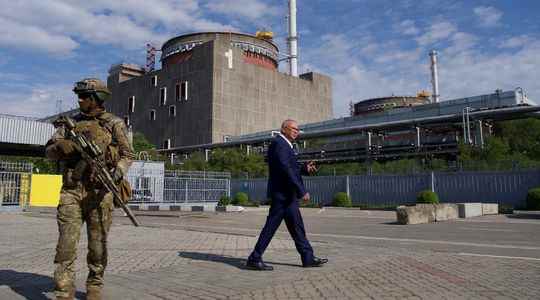This weekend, the risk of a nuclear disaster in Europe resurfaced, after shootings near the six reactors of the nuclear power plant of Zaporijjia, the largest in Europe. The first strikes were recorded in March, when the Ukrainian site was taken by the Russian army. For Bruno Chareyron, director of the Commission for Research and Independent Information on Radioactivity (CRIIRAD), this situation is a brutal reminder of the sensitivity of nuclear infrastructures in times of war.
The Express:Ukrainian atomic energy company EnergoAtom said the shelling had “seriously damaged” a station containing nitrogen and oxygen and an “auxiliary building”. A high voltage line would have been hit. Is it significant damage?
Bruno Chareyron: The operator of the plant, the safety authority and the IAEA, have indeed reported bombardments, mentioning a high voltage line and a building. Other shots were then reported, in the night from Saturday to Sunday. They would have reached a dry storage facility for spent fuel. It is difficult to know exactly what is happening and to assess the damage, without being there. Especially since the various stakeholders pass the buck, and oppose different versions. But what is certain is that all of this is very worrying. The situation since March worries us a lot at CRIIRAD.
The power of reactors 5 and 6 of the nuclear power station has been reduced to 500 MW, one of the reactors has been shut down… Are we to think that the safety of the power station has been permanently affected, and that the Russians, who occupy the central since March, are trying to cover their backs?
To guarantee the safety of a nuclear power plant, the core of each of the six reactors and the pools which contain the irradiated fuel must be permanently cooled. For this, electricity, water and personnel are needed. If a high-voltage line has indeed been damaged, the plant may have lost one of its electricity connections. There are of course other lines and diesel-powered backup generators could also take over, provided they have supplies. But a jumping line is one less safeguard.
The staff are under great pressure, which also affects the security of the site. In addition, for several weeks, it is said that the Russians have installed missile firing facilities within the plant, to reach the opposite bank of the Dnieper. It is also said that the Russian occupier also disseminated explosives. The more time passes, the more the situation deteriorates, and the more the probability of a catastrophe increases. This is not the case at the moment, but these events are very worrying, I repeat.
The IAEA says the strikes are “the latest in a long list of increasingly alarming news”. What other areas of concern?
In addition to the loss of a number of safety functions, operators have also been under intense stress since March. Part of the workforce left when the Russians captured the site. Since then, some have reported sudden and unexplained disappearances. In addition, the staff is subject to dual management, Ukrainian and Russian, which gives rise to contradictory orders. Operators point to the difficulty of having access to spare parts to operate the equipment. Some maintenance operations are not performed. We must not forget the risk associated with these working conditions, even if it impresses less than a bomb. Three Miles Island, Chernobyl…many nuclear accidents are partly due to human error.
Any attack is a “suicidal thing”, warned the UN secretary general. The International Atomic Energy Agency (IAEA) speaks of a “real risk of a nuclear disaster that could threaten health and the environment in Ukraine and beyond”. What is the risk for Ukraine and the world exactly?
There are many possible scenarios. A more or less voluntary act of sabotage cannot be excluded. One could also imagine that an aircraft flying over the area is shot down. Depending on its weight, if it falls on one of the reactors, it could also lead to disaster. Due to the disorganization on the site and possible firings which would damage the pumping capacities, it is also possible to arrive at a situation where it is no longer possible to cool one or more reactors. This is what happened in Fukushima.
In this case, little by little heating reactions would occur, hydrogen would form, until the reactor core exploded. This is the “catastrophe”. In the event of a meltdown, we could then be confronted with massive releases, into the atmosphere and into the Dnieper, the river adjacent to the plant, on a very large scale. The severity would then depend on the exact nature of the disaster, the number of reactors affected, the direction of the winds. But some scenarios include very long-range consequences.
According to the Ukrainian nuclear agency, the IAEA had a “very soft” reaction. Is the agency able to avoid the disaster?
The International Atomic Energy Agency, a branch of the UN, seems powerless. From the beginning, she was unable to change the situation in a positive way. She has been asking to conduct an inspection for months. Without success to date. The strikes in Zaporijjia demonstrate that such a situation was not really planned. And there is something. That a nuclear installation of this power has been subjected to a theater of war for months is unprecedented. It is also unpublished. I think that an awareness is in progress, on the nuclear risk in time of war. The power stations were not designed to operate in times of war.
